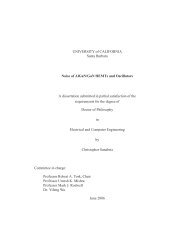Sine Wave Generation Techniques
Sine Wave Generation Techniques
Sine Wave Generation Techniques
Create successful ePaper yourself
Turn your PDF publications into a flip-book with our unique Google optimized e-Paper software.
RESONANT ELEMENT OSCILLATOR�QUARTZ<br />
CRYSTAL<br />
Quartz crystals allow high frequency stability in the face of<br />
changing power supply and temperature parameters� Figure<br />
7a shows a simple 100 kHz crystal oscillator� This Colpitts<br />
class circuit uses a JFET for low loading of the crystal� aiding<br />
stability� Regulation will eliminate the small effects (E 5<br />
ppm for 20% shift) that supply variation has on this circuit�<br />
Shunting the crystal with a small amount of capacitance allows<br />
very fine trimming of frequency� Crystals typically drift<br />
less than 1 ppm��C and temperature controlled ovens can<br />
be used to eliminate this term (Figure 7b)� The RC feedback<br />
values will depend upon the thermal time constants of the<br />
oven used� The values shown are typical� The temperature<br />
of the oven should be set so that it coincides with the crystal’s<br />
zero temperature coefficient or ‘‘turning point’’ temperature<br />
which is manufacturer specified� An alternative to temperature<br />
control uses a varactor diode placed across the<br />
crystal� The varactor is biased by a temperature dependent<br />
voltage from a circuit which could be very similar to Figure<br />
7b without the output transistor� As ambient temperature<br />
varies the circuit changes the voltage across the varactor�<br />
which in turn changes its capacitance� This shift in capacitance<br />
trims the oscillator frequency�<br />
APPROXIMATION METHODS<br />
All of the preceding circuits are inherent sine wave generators�<br />
Their normal mode of operation supports and maintains<br />
a sinusoidal characteristic� Another class of oscillator<br />
is made up of circuits which approximate the sine function<br />
through a variety of techniques� This approach is usually<br />
more complex but offers increased flexibility in controlling<br />
amplitude and frequency of oscillation� The capability of this<br />
type of circuit for a digitally controlled interface has markedly<br />
increased the popularity of the approach�<br />
TL�H�7483–9<br />
(a) (b)<br />
(c)<br />
TL�H�7483–11<br />
FIGURE 7� Stable quartz-crystal oscillators can operate with a single active device (a)� You can achieve<br />
maximum frequency stability by mounting the oscillator in an oven and using a temperature-controlling<br />
circuit (b)� A varactor network (c) can also accomplish crystal fine tuning� Here� the varactor replaces the<br />
oven and retunes the crystal by changing its load capacitances�<br />
6<br />
TL�H�7483–10









